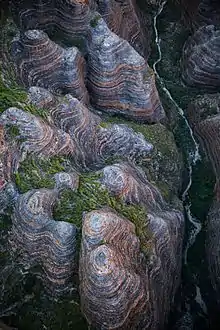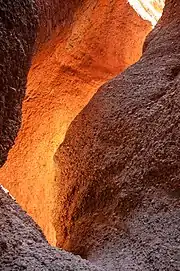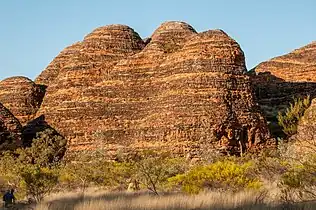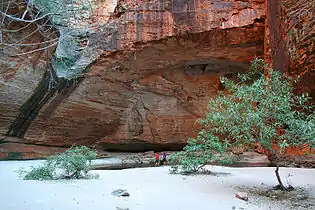Purnululu National Park
The Purnululu National Park is a World Heritage Site in the East Kimberley region of Western Australia. The 239,723-hectare (592,370-acre) national park is located approximately 300 kilometres (190 mi) south of Kununurra, with Halls Creek located to the south. Declared a World Heritage Site in 2003, the park was inscribed as follows:[3]
...[is a] remote area managed as wilderness. It includes the Bungle Bungle Range, a spectacularly incised landscape of sculptured rocks which contains superlative examples of beehive-shaped karst sandstone rising 250 metres above the surrounding semi-arid savannah grasslands. Unique depositional processes and weathering have given these towers their spectacular black and orange banded appearance, formed by biological processes of cyanobacteria (single cell photosynthetic organisms) which serve to stabilise and protect the ancient sandstone formations. These outstanding examples of cone karst that have eroded over a period of 20 million years are of great beauty and exceptional geological interest.

| Purnululu National Park Western Australia | |
|---|---|
 Echidna Chasm | |
 Purnululu National Park | |
| Nearest town or city | Halls Creek |
| Coordinates | 17°27′47″S 128°33′51″E |
| Population | 13 (SAL 2021)[1] |
| Established | 1987 |
| Area | 2,397.23 km2 (925.6 sq mi)[2] |
| Region | AU-WA |
| Managing authorities | WA Department of Parks and Wildlife |
| Website | Purnululu National Park |
| Footnotes | |
| Criteria | Natural: vii, viii |
| Reference | 1094 |
| Inscription | 2003 (27th Session) |
| See also | List of protected areas of Western Australia |
Purnululu National Park World Heritage Site
The World Heritage status of the region was created and negotiated in 2003, and the adopted boundary of the existing national park.[4] Since its listing, the Government of Western Australia has reserved additional areas located adjacent to the World Heritage Area, including the Purnululu Conservation Park and the Ord River Regeneration Reserve.[3] The site was gazetted on the Australian National Heritage List on 21 May 2007 under the Environment and Heritage Legislation Amendment Act (No. 1), 2003 (Cth).[5]
Etymology
Purnululu is a mispronounced Djaru word for the area around Bungle Bungle out camp, which is referred to as Bullmanlulu. The correct Karjaganujaru name for the Bungle Bungle massif is Billingjal which means sand falling away.[6]
The traditional owners of the area are the Karjaganujaru peoples.[7]
Features
The Bungle Bungle Range, lying fully within the park, has elevations as high as 578 metres (1,896 ft) above sea level. It is famous for the sandstone domes, unusual and visually striking with their striping in alternating orange and grey bands. The banding of the domes is due to differences in clay content and porosity of the sandstone layers: the orange bands consist of oxidised iron compounds in layers that dry out too quickly for cyanobacteria to multiply; the grey bands are composed of cyanobacteria growing on the surface of layers of sandstone where moisture accumulates.
Geology
The Bungle Bungle Range is one of the most extensive and impressive occurrences of sandstone tower (or cone) karst terrain in the world. The Bungle Bungles were a plateau of Devonian sandstone, carved into a mass of beehive-shaped towers with regularly alternating, dark gray bands of cyanobacterial crust (single cell photosynthetic organisms). The plateau is dissected by 100–200-metre (330–660 ft) deep, sheer-sided gorges and slot canyons. The cone-towers are steep-sided, with an abrupt break of slope at the base and have domed summits. How they were formed is not yet completely understood. Their surface is fragile but stabilized by crusts of iron oxide and bacteria. They provide an outstanding example of land formation by dissolutional weathering of sandstone, with removal of sand grains by wind, rain and sheet wash on slopes.[8]
Access
Access to the park by road is via Spring Creek Track, from the Great Northern Highway approximately 250 kilometres (160 mi) south of Kununurra, to the track's end at the visitor centre. The track is 53 kilometres (33 mi) long and is usable only in the dry season (about 1 April to 31 December) by four-wheel-drive vehicles. Safely navigating it takes approximately three hours. Access by air is less demanding; helicopter flights are available from Bellburn Airstrip[9] in the national park, and from Warmun roadhouse.[10] Scenic light aircraft flights are also available out of Kununurra and Lake Argyle.
Gallery
 The Domes Walk
The Domes Walk Cathedral Gorge
Cathedral Gorge Aerial view of a canyon
Aerial view of a canyon
References
- Australian Bureau of Statistics (28 June 2022). "Purnululu (Suburb and Locality)". Australian Census 2021 QuickStats. Retrieved 28 June 2022.
- "Department of Environment and Conservation 2009–2010 Annual Report". WA Department of Environment and Conservation. Government of Western Australia: 48. 2010. ISSN 1835-114X. Archived from the original on 11 January 2011.
- "Purnululu National Park". World Heritage List. UNESCO. 2014. Retrieved 30 August 2014.
- "Purnululu National Park (Australia)". Committee Decisions. UNESCO World Heritage Convention. 2003. Retrieved 30 August 2014.
- "Determination regarding including World Heritage places in the National Heritage List" (PDF). Special government gazette (PDF). Department of the Environment and Water Resources, Commonwealth of Australia. 21 May 2007. Retrieved 30 August 2014.
- Spoken by Djaru Traditional owner Bonnie Edwards
- Five Anthropologist proven its Djaru land
- "Purnululu National Park, Australia". Encyclopedia of Earth.
- "Bellburn Airstrip | Explore Parks WA | Parks and Wildlife Service".
- "Darwin to Perth Day 3 - Kununurra to Fitzroy Crossing | Still as Life". 9 January 2017.
Further reading
- Hoatsan, Dean et al.(1997) Bungle Bungle Range : Purnululu National Park, East Kimberley, Western Australia : a guide to the rocks, landforms, plants, animals, and human impact Canberra : Australian Geological Survey Organisation. ISBN 0-642-25010-3